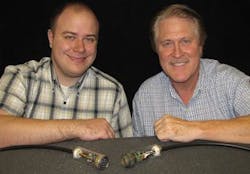Optical power-over-fiber cable provides total electrical isolation
Albuquerque, NM--A novel fiber-optic communications cable developed at Sandia National Laboratories sends power optically rather than electrically to the communications electronics integral to the cable. The power-over-fiber (PoF) cable thus provides total electrical isolation in every way—a property valuable for applications related to safety, such as security, explosives, explosion-proof devices, aviation, and medical devices.
It's common to isolate communications between systems or devices by using fiber-optic cables, says Steve Sanderson of Sandia's mobility analysis and technical assessment division. But when power also is required, sending it down a copper wire can at times be a safety issue, and substituting it with battery power may not be suitable or practical, he said.
Sanderson, Titus Appel, and Walter Wrye, a former Sandia intern, are co-inventors of the new cable. A patent is pending on the design.
"The PoF cable has power limitations," Sanderson says. "It's not to be construed as a means to power your house, for example, or handle the high speeds of a computer network. But because there are growing needs of low-power sensor/control applications related to safety, having convenient optically generated power available is a tremendous benefit."
The PoF cable ends resemble a typical copper electrical cable with pin and socket connectors. However, optical interface circuits integrated into the connector housing, called a backshell, provide fiber-optic transmission of both data communications and optical power.
To conserve energy, optical power is delivered only on demand, Sanderson says.
"The key issue here is to maintain total electrical isolation from any stray electrical energy and high-voltage electrical surges caused by such things as lightning strikes," he says.
The first-generation PoF cable just delivers optical power to the cable's internal electronics for data communication between devices. The researchers now are adding the capability to deliver electrical power externally to a connected low-power device, notes Sanderson.
In the cable's current version, the backshell encapsulates circular stacked circuit boards with LEDs coupled to plastic optical fibers for communications, and a laser diode and miniaturized photovoltaic-type cell coupled to the ends of a single glass fiber to deliver optical power.
In the next version, the team plans to use only glass fibers. "Although plastic fiber requires less preparation time than glass, it takes up more room," says Sanderson.
The team recently tested a PoF low-energy detonator firing cable with fireset electronics built into the backshell. The optically powered fireset embeds a microcontroller that reports such things as detonator resistance, temperature, and charging voltages, and receives command messages to fire the detonator. When it's idle or powered down, the circuitry is designed to short the detonator input leads to prevent unwanted electrical energy from reaching it.
The researchers are working with next-generation microcontrollers, new packaging layouts, and new optical devices to reduce the size. Team members also are developing a rugged, production-ready PoF cable and are working to reduce the backshell's length, decrease the weight, and lower costs.

John Wallace | Senior Technical Editor (1998-2022)
John Wallace was with Laser Focus World for nearly 25 years, retiring in late June 2022. He obtained a bachelor's degree in mechanical engineering and physics at Rutgers University and a master's in optical engineering at the University of Rochester. Before becoming an editor, John worked as an engineer at RCA, Exxon, Eastman Kodak, and GCA Corporation.
